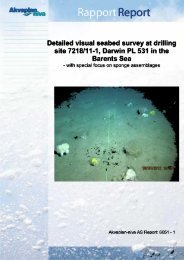A study of the priority substances of the Water Framework Directive ...
A study of the priority substances of the Water Framework Directive ...
A study of the priority substances of the Water Framework Directive ...
Create successful ePaper yourself
Turn your PDF publications into a flip-book with our unique Google optimized e-Paper software.
..:::::::::: chlorpyrifos<br />
..:::28<br />
9 Chlorpyrifos<br />
� Chlorpyrifos is one <strong>of</strong> <strong>the</strong> most common<br />
insecticides worldwide. Increased popularity following<br />
DDT ban.<br />
� The substance has been found on imported<br />
fruit and vegetables, but data on use and distribution<br />
in Norway are limited.<br />
� There are no data on environmental distribution<br />
in Norway.<br />
� There is no fur<strong>the</strong>r need for screening <strong>of</strong><br />
Chlorpyrifos in Norway.<br />
Production and use<br />
In Norway, Chlorpyrifos has been used as insecticide<br />
for ants. No sales for agricultural purposes<br />
found in documentation on use and sales <strong>of</strong><br />
pesticides. No entries in <strong>the</strong> Product Register<br />
since 2000.<br />
Chlorpyrifos has been restricted banned from<br />
agricultural use in in Sweden from 2001, but<br />
becomes legal from 2005 as pesticide also due<br />
to EC regulations.<br />
It has also been used in veterinary and human<br />
medicine (lice).<br />
Emissions, discharges,<br />
distribution and hot-spots<br />
Chlorpyrifos may be found around arable lands<br />
and possibly in landfills.<br />
Monitoring<br />
Chlorpyrifos has been screened in Sweden and<br />
only been found in very low concentrations in a<br />
fresh water stream and in compost. There are<br />
no data on environmental distribution in<br />
Norway.<br />
Need for fur<strong>the</strong>r screening and monitoring<br />
The use <strong>of</strong> chlorpyrifos in Norway has been<br />
very limited, and chlorpyrifos has not been<br />
found in <strong>the</strong> environment. There is no need for<br />
fur<strong>the</strong>r screening or monitoring <strong>of</strong> chlorpyrifos.<br />
Analysis<br />
The analysis <strong>of</strong> chlorpyrifos is <strong>of</strong>ten part <strong>of</strong><br />
multi pesticide packages <strong>of</strong>fered by several laboratories.<br />
A <strong>study</strong> <strong>of</strong> <strong>the</strong> <strong>priority</strong> <strong>substances</strong> <strong>of</strong> <strong>the</strong> <strong>Water</strong> <strong>Framework</strong> <strong>Directive</strong><br />
TA-2140/2005<br />
FACTS<br />
Cas no.: 2921-88-2<br />
Synonyms: Klorpyrifos, Dursban, chlorpyriphos (F-ISO,<br />
JMAF), 0,0-Diethyl-0-3,5,6-trichlor-2-pyridylthiophosphat.<br />
Properties: Granules, wettable powder, dustable<br />
powder, and emulsifiable concentrate.<br />
Toxic effects: Chlorpyrifos is toxic to humans. LD50 in<br />
rats is 95 to 270 mg/kg. Skin and eye irritant. Toxic to<br />
highly toxic to birds. Highly toxic to fresh water fish,<br />
aquatic invertebrates and estuarine and marine<br />
organisms. The 96-hour LC50 in rainbow trout<br />
(Oncorhynchus mykiss) is 0,009 mg/L. Toxic to some<br />
plants.<br />
Log Kow: 4,66<br />
Persistence: Up to 1 year in soil, half-life up to 80<br />
days in water, may persist longer in groundwater and<br />
sediments. BCF value 2,67. (HSDB)<br />
DT50 water = 3-6 days<br />
DT50 whole system = 22 -51 days (CIRCA)<br />
<strong>Water</strong> solubility: 0,357 mg/l (25°C)<br />
Molecular formula: C 9 -H 11 -Cl 3 -N-O 3 -P-S<br />
Metabolites: 3,5,6-trichloro-2-pyridinol (urine), (3,5,6trichloro-2-pyridyl)phosphate.<br />
Use: Insecticide. One <strong>of</strong> <strong>the</strong> pesticides most <strong>of</strong>ten<br />
found in amounts exceeding <strong>the</strong> maximum residue<br />
level according to Mattilsynet (2003).<br />
Methods<br />
The methods are based on direct extraction with<br />
an organic solvent (sediment and biota) or solid<br />
phase extraction (SPE), eventually clean-up with<br />
SPE and separation and quantification with GCbased<br />
methods: GC/MS or GC/NPD.<br />
Synergy with o<strong>the</strong>r analyses<br />
Sample extraction and clean-up can be co-ordinated<br />
with <strong>the</strong> analysis <strong>of</strong> o<strong>the</strong>r pesticides which<br />
can be analysed by GC/MS especially o<strong>the</strong>r<br />
organophosphorous insecticides as for example<br />
chlorfenvinphos, malathion or methylparathion.<br />
References<br />
� Royal Haskoning: Fact sheets on production,<br />
use and release <strong>of</strong> <strong>priority</strong> <strong>substances</strong> in <strong>the</strong>

















